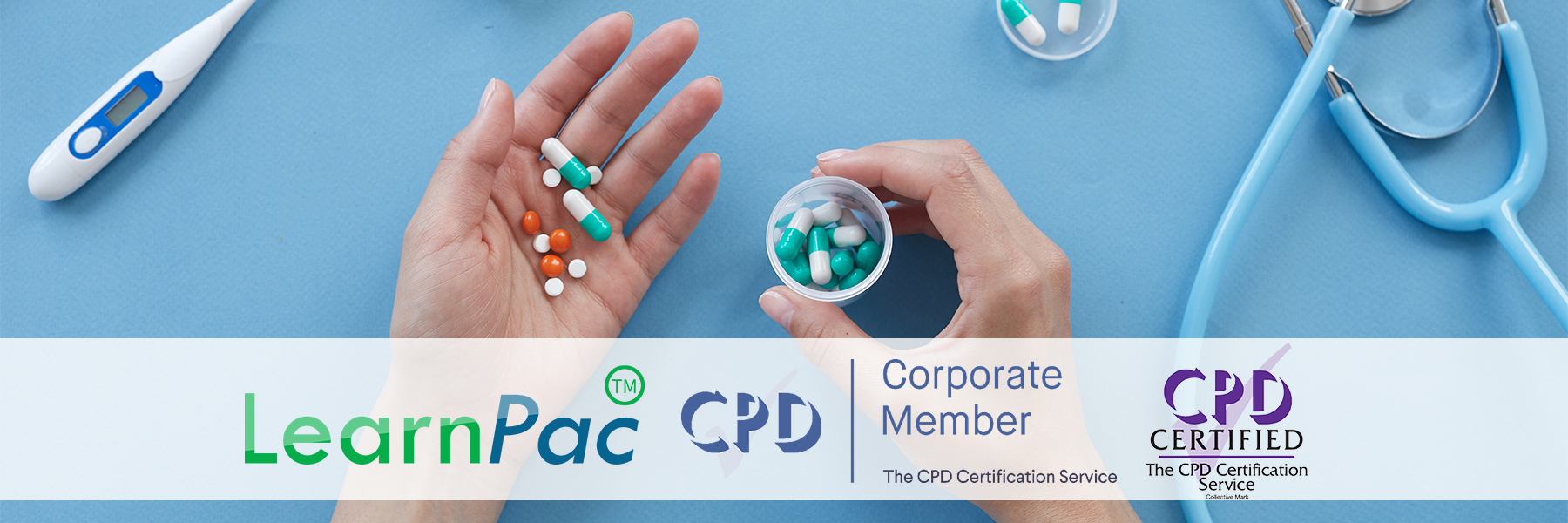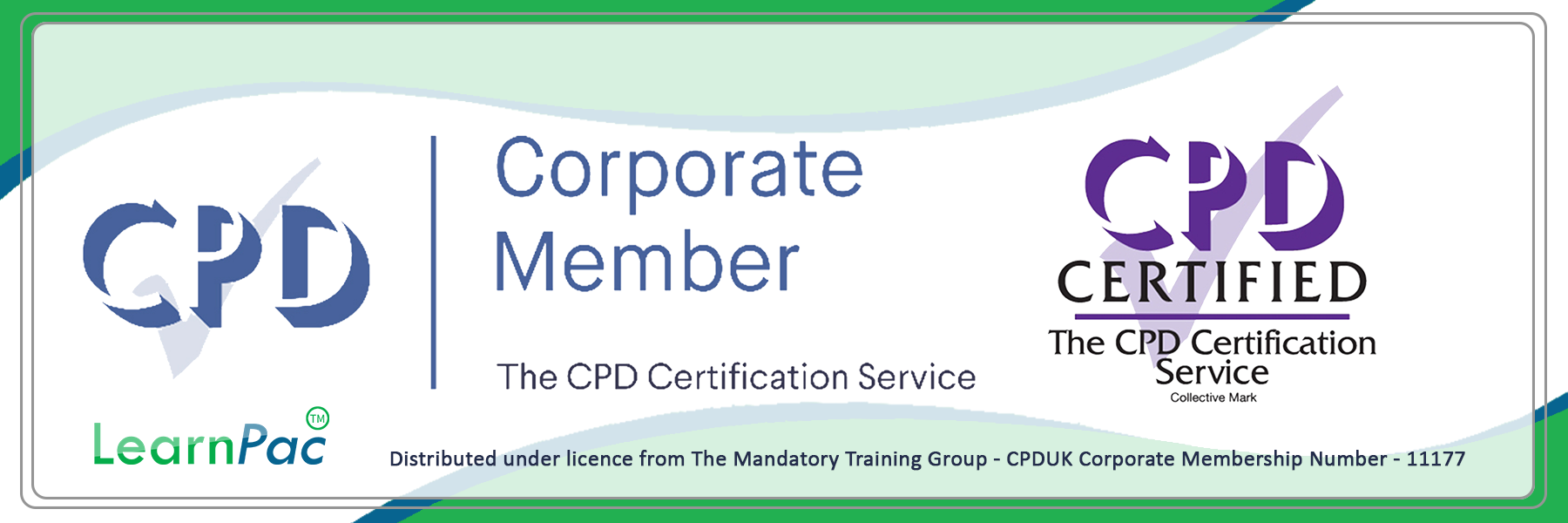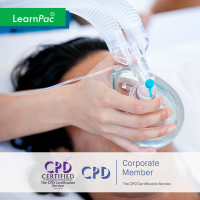Drug Calculations Training - E-Learning Courses - CPDUK Accredited

Drug Calculation Training – E-Learning Courses with Certificates – CPDUK Accredited Online Courses.
The LearnPac Systems is the leading UK provider of accredited statutory and mandatory training courses for all sectors, including health and social care, education, local government, private and charity sectors.
Insufficient skills in drug dose calculations increase the risk of medication errors. Even experienced nurses may struggle with drug dose calculations. Learning flexibility and cost considerations make e-learning an interesting alternative to classroom teaching. Most nurses and other clinical staff will often be called upon to administer or supervise the administration of all types of medicines in different forms and strengths.
The aims of these drug calculations training is to improve the skills of nurses and other healthcare staff in calculating drug dosages accurately and avoiding drug errors.
Browse our Drug Calculation Training - E-Learning Courses
Drug Calculations Training: Frequently Asked Questions and Answers
Drug Calculations Training – Online Training Courses with Certificates – CPDUK Accredited – LearnPac Systems UK.
Here at LearnPac, we received many questions about drug calculations. We have provided answers to the most frequently asked questions about drug calculations.
Click on the text below to see the answers to the Frequently Asked Questions about Drug Calculations.
Drug calculations require the use of conversion factors, such as when converting pounds to kilograms or litres to millilitres.
LearnPac System offers a wide range of health and safety training courses for healthcare and social care providers, including sector-specific e-learning bundles, train the trainer courses and professionally developed trainer materials and resources.
Click here for Drug Dosage Calculations – Online Training Course – CPD Accredited.
A drug calculation test is an examination of your ability to efficiently work through mental arithmetic associated with drug administration. Drug calculation refers to working with dosage formulas, weights and volume, translating different types of measurements and working out dosage schedules.
LearnPac System offers a wide range of health and safety training courses for healthcare and social care providers, including sector-specific e-learning bundles, train the trainer courses and professionally developed trainer materials and resources.
Click here for Drug Dosage Calculations – Online Training Course – CPD Accredited.
Fried’s rule is a method of estimating the dose of medication for a child by dividing the child’s age in months by 150 and multiplying the result by the adult dose.
LearnPac System offers a wide range of health and safety training courses for healthcare and social care providers, including sector-specific e-learning bundles, train the trainer courses and professionally developed trainer materials and resources.
Click here for Drug Dosage Calculations – Online Training Course – CPD Accredited.
Find out what is in your IV bottle (drug concentration or the number of mL of fluid).
- Identify which unit your drug is measured (units/hour, mg/hour, or mcg/kg/minute).
- Know the patient’s weight in kg if your calculation is weight-based.
- Use the universal formula and then divide your final answer by the patient’s weight in kg to arrive at mcg/kg/minute.
LearnPac System offers a wide range of health and safety training courses for healthcare and social care providers, including sector-specific e-learning bundles, train the trainer courses and professionally developed trainer materials and resources.
Click here for Drug Dosage Calculations – Online Training Course – CPD Accredited.
The total daily dose is calculated from the dose and the number of times per day the dose is taken. The dosage form is the physical form of a dose of a drug. The strength is the amount of drug in the dosage form or a unit of the dosage form (e.g. 500 mg capsule, 250 mg/5 mL suspension).
LearnPac System offers a wide range of health and safety training courses for healthcare and social care providers, including sector-specific e-learning bundles, train the trainer courses and professionally developed trainer materials and resources.
Click here for Drug Dosage Calculations – Online Training Course – CPD Accredited
Most drugs stay in the body for at least a few days after the last use and are traceable with urine tests. Opioids, such as heroin and oxycodone, are detectable for between 1 and 3 days after last use. Stimulants, including cocaine, meth, and ADHD medications are detectable for about 2 or 3 days.
Drug volume refers to the volume of distribution that is necessary to contain the total amount of an administered drug at the same concentration that is observed in the blood plasma.
Drug concentration is the amount of a drug in a given volume of blood plasma. It is measured as the number of micrograms per millilitre.
LearnPac System offers a wide range of health and safety training courses for healthcare and social care providers, including sector-specific e-learning bundles, train the trainer courses and professionally developed trainer materials and resources.
Click here for Drug Dosage Calculations – Online Training Course – CPD Accredited.
The drops per minute would be calculated as total volume, divided by time (in minutes), multiplied by the drop factor of 60 gtts/min, which also equals 41.6, rounded to 42 drops per minute.
Most drugs in children are calculated according to body weight (mg/kg) or body surface area (BSA) (mg/m2). It is essential to be mindful in converting body weight from pounds to kilograms (1 kg= 2.2 lb) before calculating doses based on body weight.
LearnPac System offers a wide range of health and safety training courses for healthcare and social care providers, including sector-specific e-learning bundles, train the trainer courses and professionally developed trainer materials and resources.
Click here for Drug Dosage Calculations – Online Training Course – CPD Accredited.
Medication calculation skills also make it possible to interpret the instructions written by a physician or prescriber correctly. Also, drug calculations allow nurses to monitor for potential side effects and to make decisions in discontinuing the medication in case of a severe reaction.
LearnPac System offers a wide range of health and safety training courses for healthcare and social care providers, including sector-specific e-learning bundles, train the trainer courses and professionally developed trainer materials and resources.
Click here for Drug Dosage Calculations – Online Training Course – CPD Accredited.
Determine in which units your drug is measured (units/hour, mg/hour, or mcg/kg/minute). Know the patient’s weight in kg if your calculation is weight-based. Use the universal formula, and divide your final answer by the patient’s weight in kg to arrive at mcg/kg/minute.
Drug calculations require the use of conversion factors. Simplistic in design, this method allows clinicians to work with various units of measurement, converting factors to find the answer. These methods are useful in checking the accuracy of other calculation methods and in acting as a double or triple check.
Medication calculation skills also make it possible to interpret the instructions written by a physician or prescriber correctly. Competent numerical and drug calculation skills are essential for nurses as mistakes can put patients’ lives at risk.
LearnPac System offers a wide range of health and safety training courses for healthcare and social care providers, including sector-specific e-learning bundles, train the trainer courses and professionally developed trainer materials and resources.
Click here for Drug Dosage Calculations – Online Training Course – CPD Accredited.
According to the American Heart Association (AHA), to calculate dopamine infusion rate, multiply 6 times the weight in kg times the desired dose in µg/ kg/min. Divide it by the desired amount of fluid to infuse in ml/h, which provides the amount of dopamine in mg to add to each 100 ml solution prepared.
The three primary methods for calculation of medication dosages include dimensional analysis, ratio proportion and desired over have or formula.
LearnPac System offers a wide range of health and safety training courses for healthcare and social care providers, including sector-specific e-learning bundles, train the trainer courses and professionally developed trainer materials and resources.
Click here for Safe Handling of Medication in Home Care – Online Training Course.
Prescription drug dosage is based typically on body weight. Drugs come with a recommended dose in milligrams or micrograms per kilogram of body weight, and that is used in conjunction with the patient’s body weight to determine a safe dosage.
LearnPac System offers a wide range of health and safety training courses for healthcare and social care providers, including sector-specific e-learning bundles, train the trainer courses and professionally developed trainer materials and resources.
Click here for Safe Handling of Medication in Home Care – Online Training Course.
Most drug dosages are measured by weight in grams, milligrams or micrograms. However, certain special drugs have other metric units that measure properties other than weight.
Drop factor is the number of drops that it takes to equal 1 mL of fluid when using a specific type of IV tubing. The drop size in an IV set depends on the width of the tubing.
Prescription smart drugs, such as Adderall and Ritalin, have the strongest and most significant effects on memory and attention. Synthetic nootropic supplements, such as Noopept and Piracetam, are widely available. However, there is not enough evidence of their effectiveness in healthy adults.
LearnPac System offers a wide range of health and safety training courses for healthcare and social care providers, including sector-specific e-learning bundles, train the trainer courses and professionally developed trainer materials and resources.
Click here for Drug Dosage Calculations – Online Training Course – CPD Accredited.
Drugs affect feelings and moods, judgment, decision-making, learning and memory. They can also cause or worsen other health problems such as cancer, heart disease, lung disease, liver function, mental disorders and infectious diseases like HIV/AIDS, hepatitis and tuberculosis.
The action of drugs on the human body is called pharmacodynamics, and what the body does with the drug is called pharmacokinetics. The drugs that enter the human tend to stimulate specific receptors, ion channels, act on enzymes or transporter proteins. As a result, they cause the human body to react in a particular way.
The study of drugs or chemicals and the effects they have is called pharmacology. Pharmacology explains what drugs are, what they do to body functions, and what the body does to them.
The main types of drugs are as follows:
- Stimulants, such as cocaine
- Depressants, including alcohol
- Opium-related painkillers, such as heroin
- Hallucinogens like LSD
LearnPac System offers a wide range of health and safety training courses for healthcare and social care providers, including sector-specific e-learning bundles, train the trainer courses and professionally developed trainer materials and resources.
Click here for Drug Dosage Calculations – Online Training Course – CPD Accredited.
The following drugs are six of the most dangerous:
- Foxy Methoxy
- Khat
- Dragonfly
- Benzo Fury
- Scopolamine
- Krokodil.
Fentanyl is an opioid used as a pain medication and together with other medications for anaesthesia. Fentanyl is also used as a recreational drug, often mixed with heroin or cocaine. It has a rapid onset and its effects generally last less than two hours. It is similar to morphine but is 50 to 100 times more potent.
In pharmacology, a drug is a chemical substance, typically of known structure, which, when administered to a living organism, produces a biological effect. A pharmaceutical drug, which is also known as a medication or medicine, is a chemical substance used to treat, cure, prevent, or diagnose a disease or to promote wellbeing.
LearnPac System offers a wide range of health and safety training courses for healthcare and social care providers, including sector-specific e-learning bundles, train the trainer courses and professionally developed trainer materials and resources.
Click here for Drug Dosage Calculations – Online Training Course – CPD Accredited.
The Weight-Based Dose Calculator is used for weight-based dosing. The parameters for the calculator include dosage, weight, med amount and per volume.
LearnPac System offers a wide range of health and safety training courses for healthcare and social care providers, including sector-specific e-learning bundles, train the trainer courses and professionally developed trainer materials and resources.
Click here for Drug Dosage Calculations – Online Training Course – CPD Accredited.
On successful completion of the drug calculations training courses will be able to download, save and/or print a quality assured continuing professional development (CPD) certificate. Our CPD certificates are recognised internationally and can be used to provide evidence for compliance and audit.
The CPD Certification Service (CPDUK) accredits all of our statutory and mandatory training courses as conforming to universally accepted Continuous Professional Development (CPD) guidelines.
LearnPac Systems is distributed under the licence from The Mandatory Training Group – CPDUK Corporate Memebrship Number – 1117




